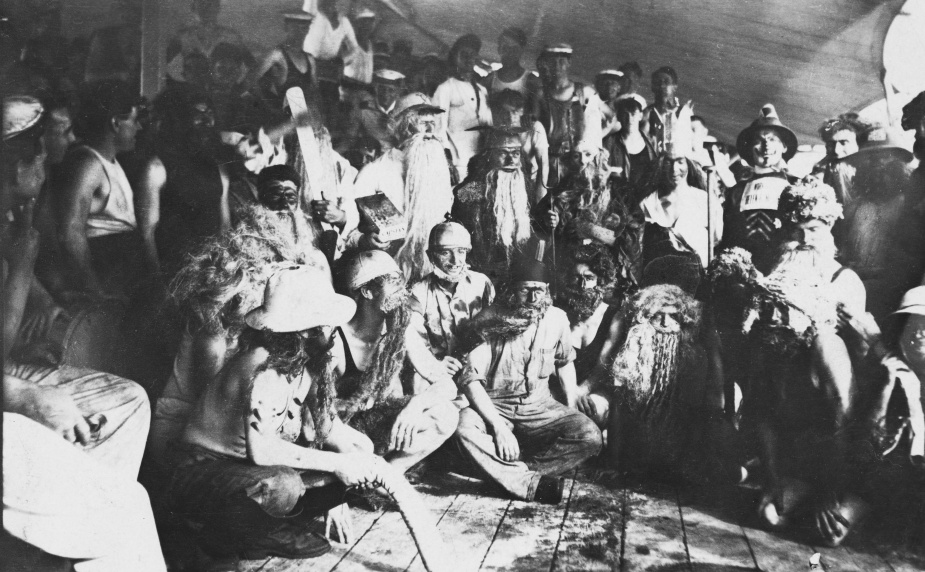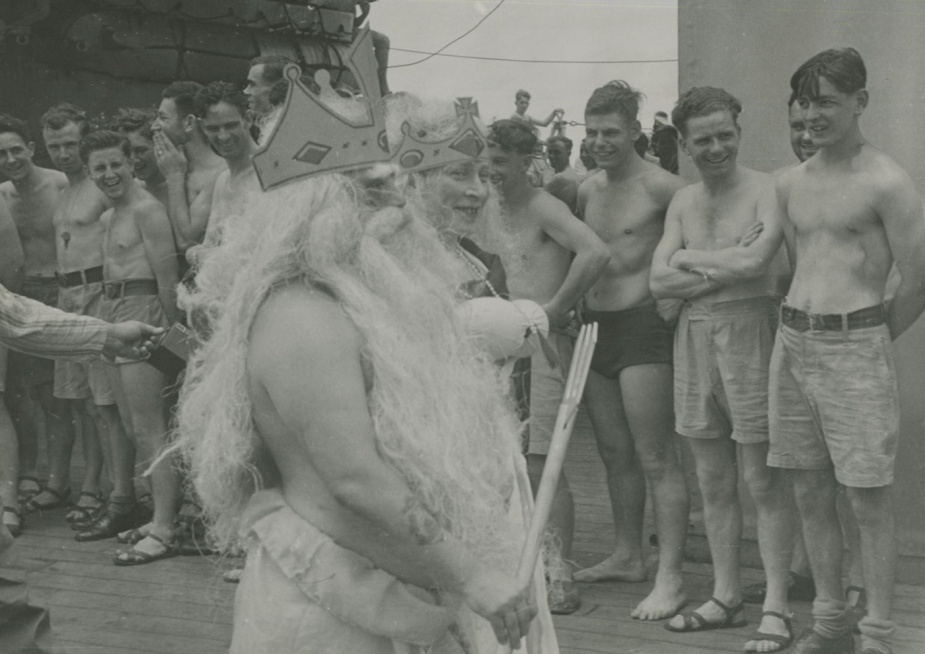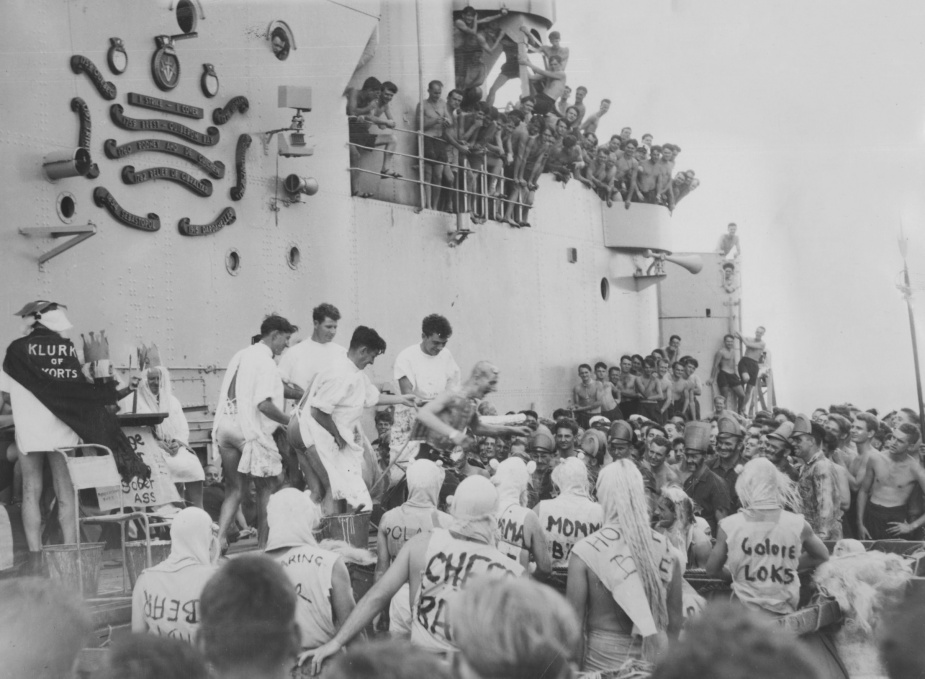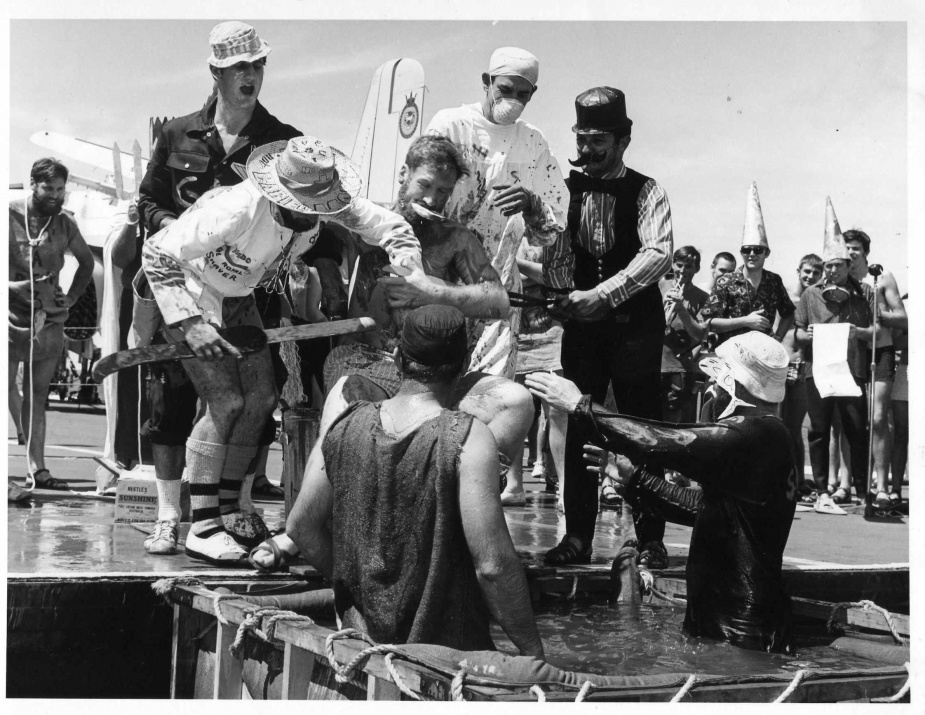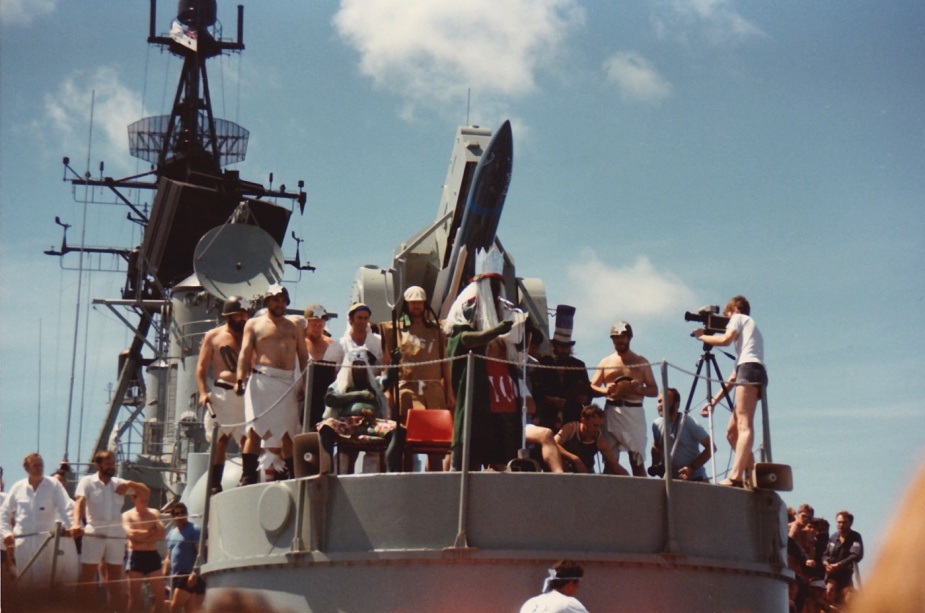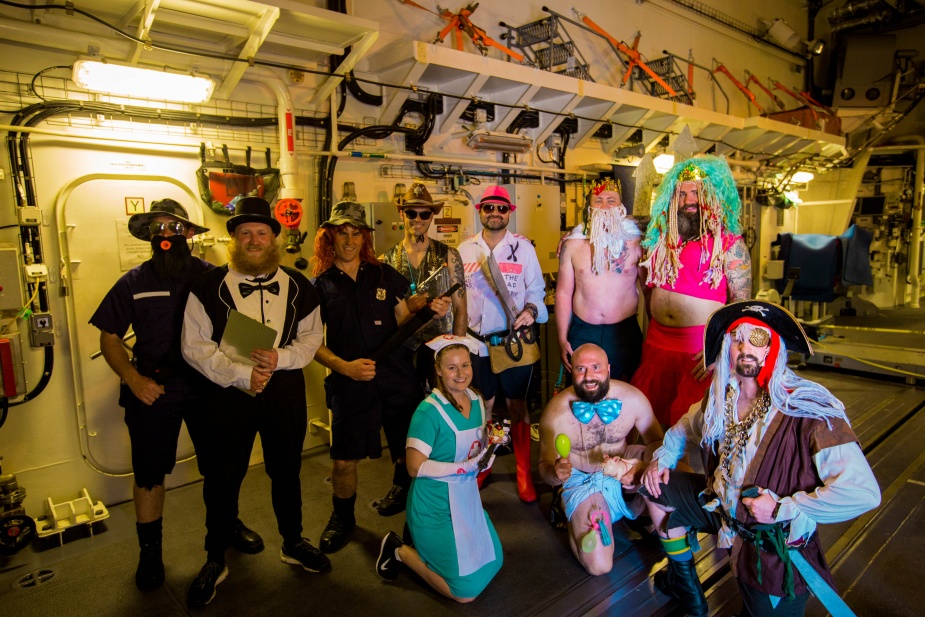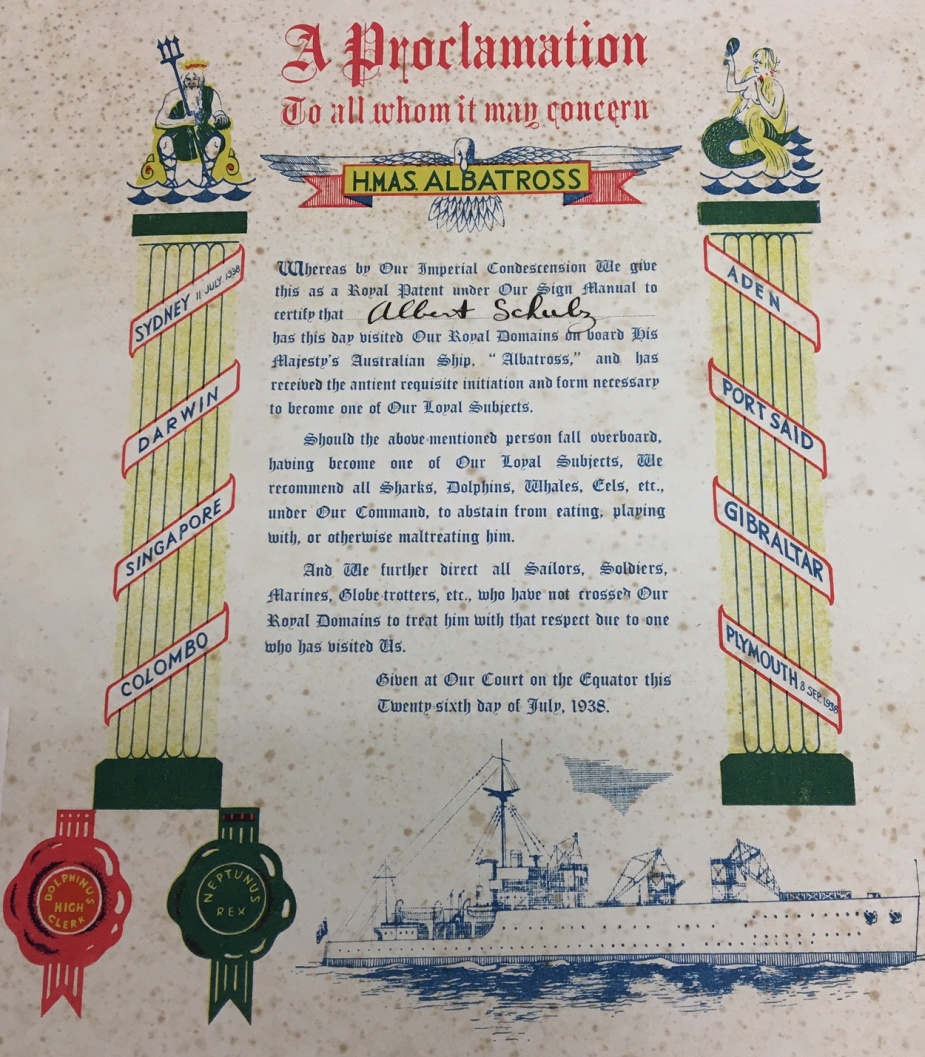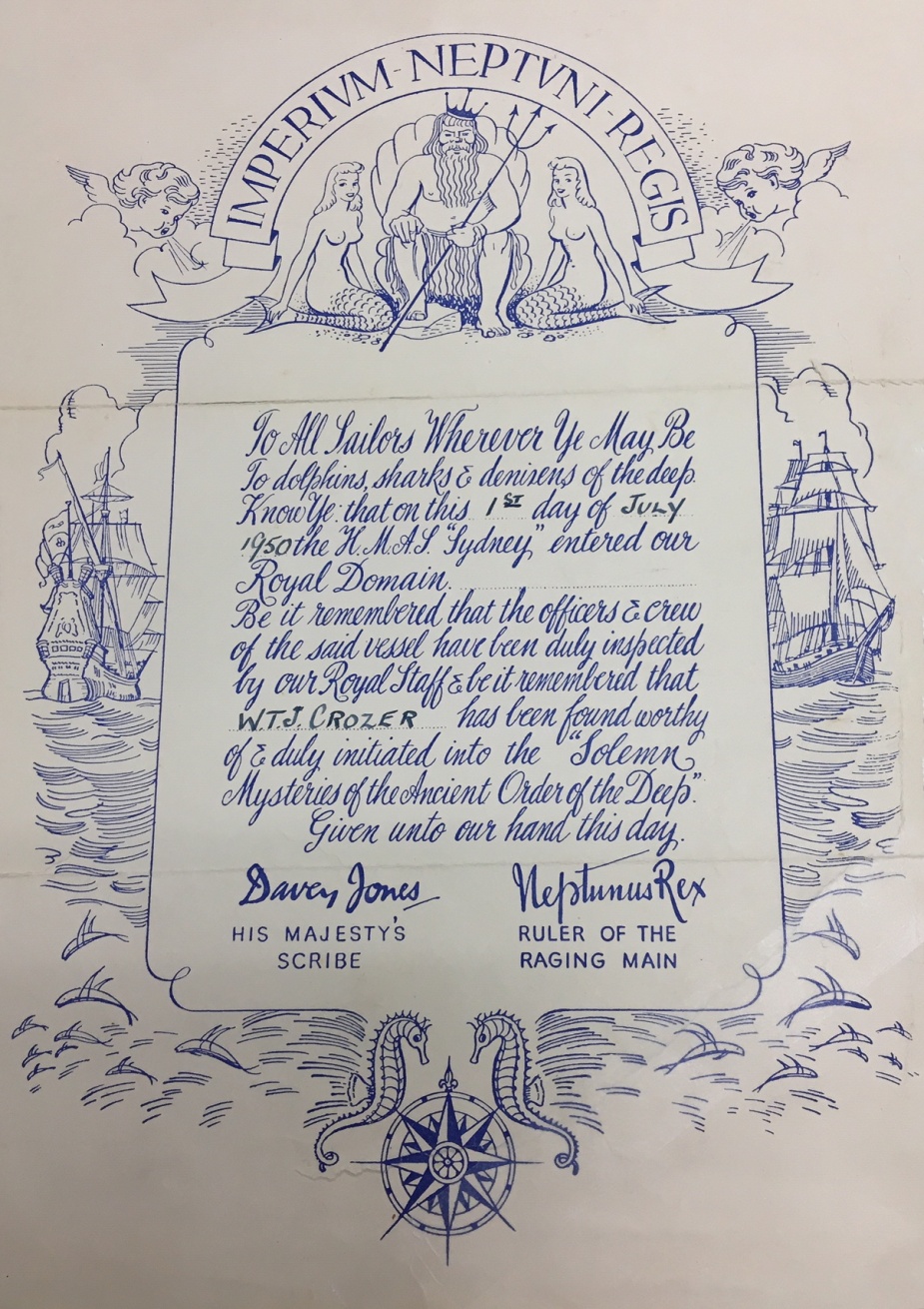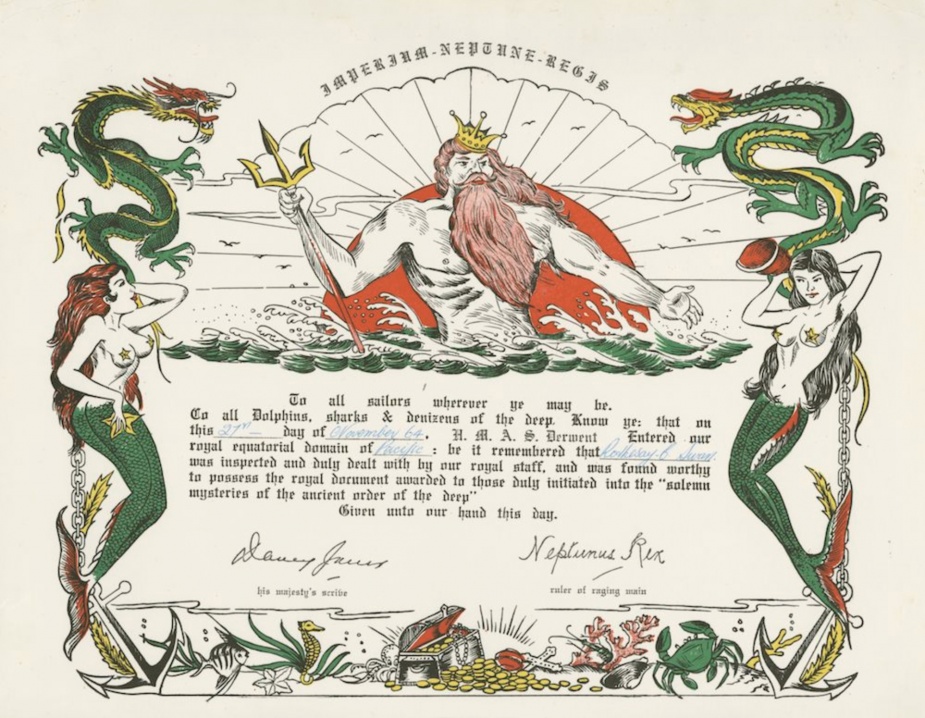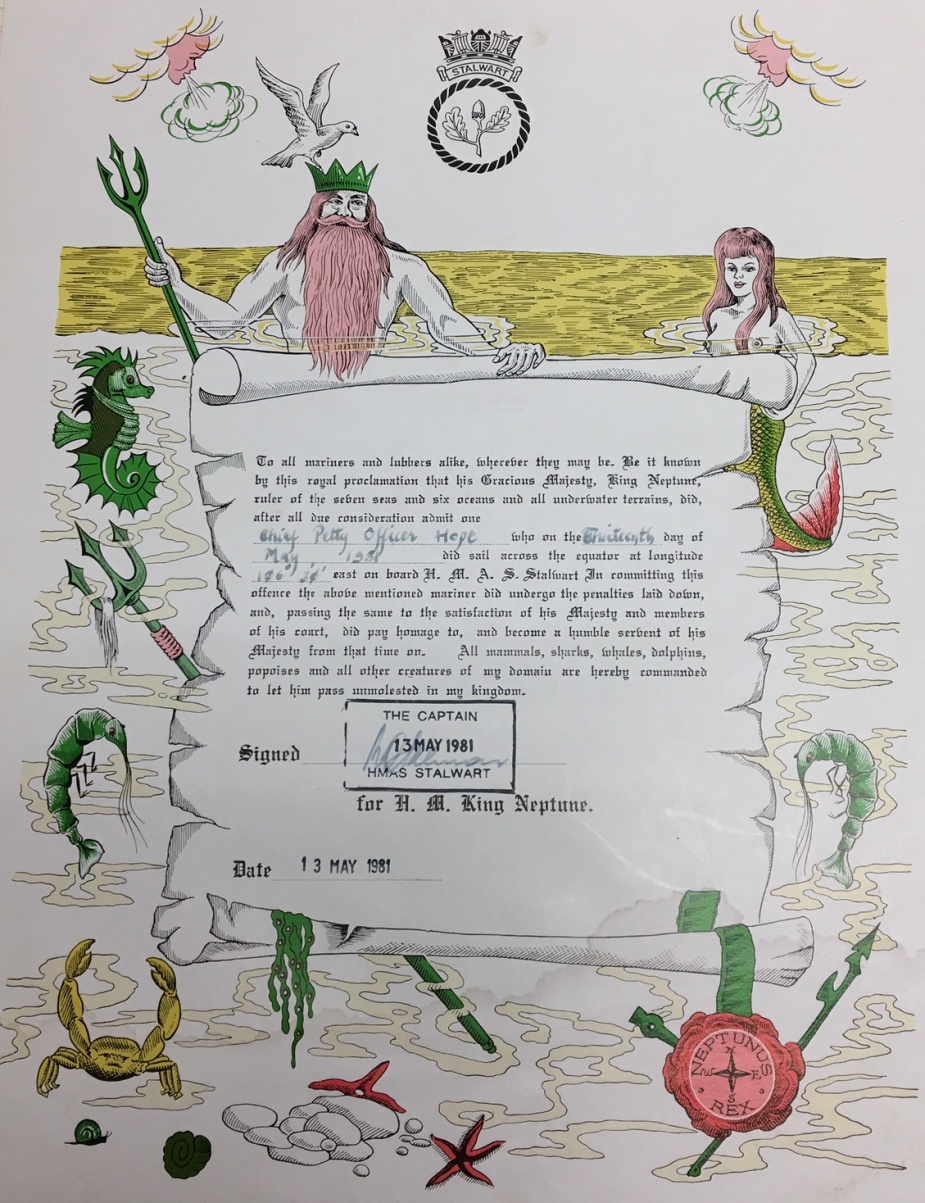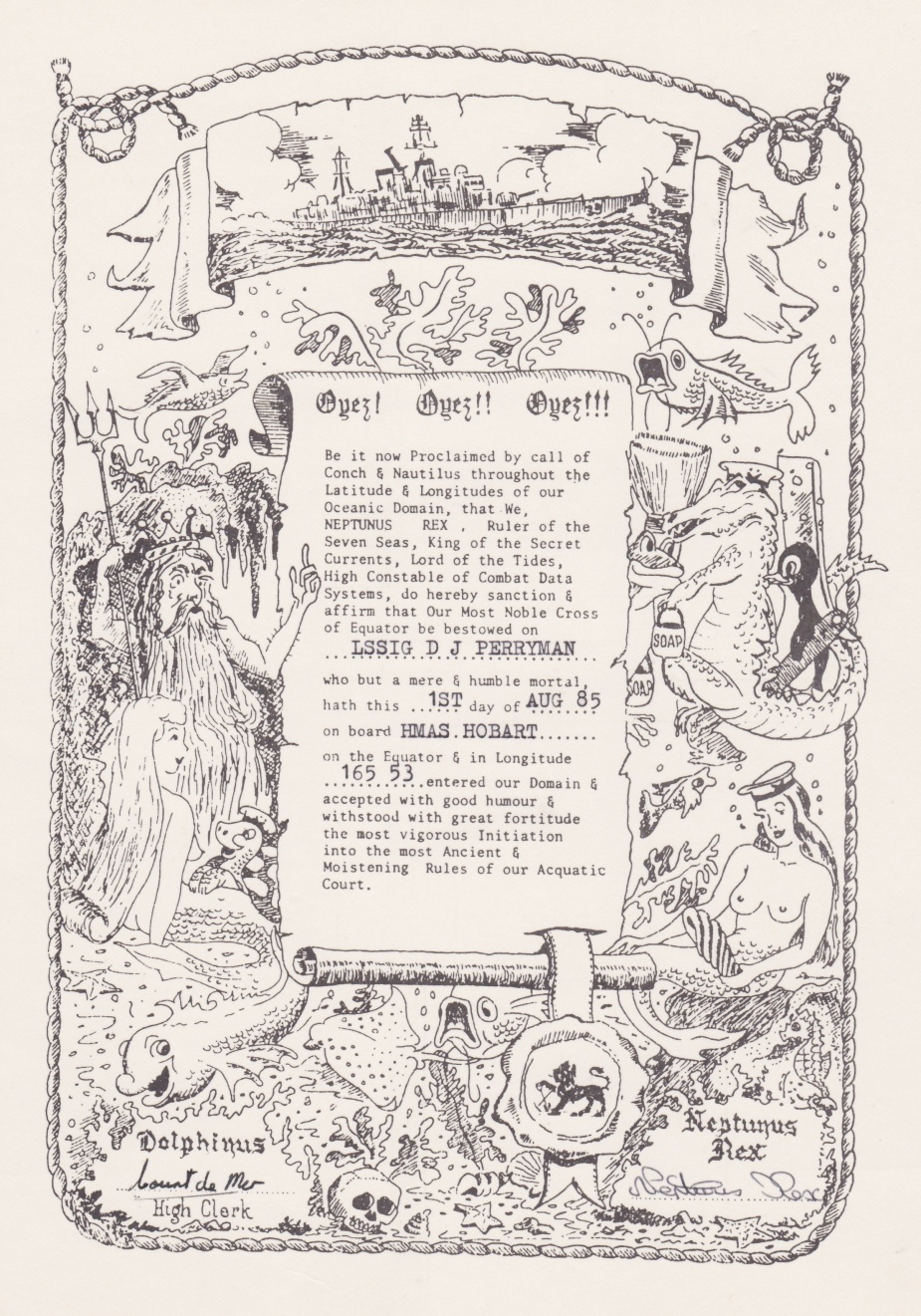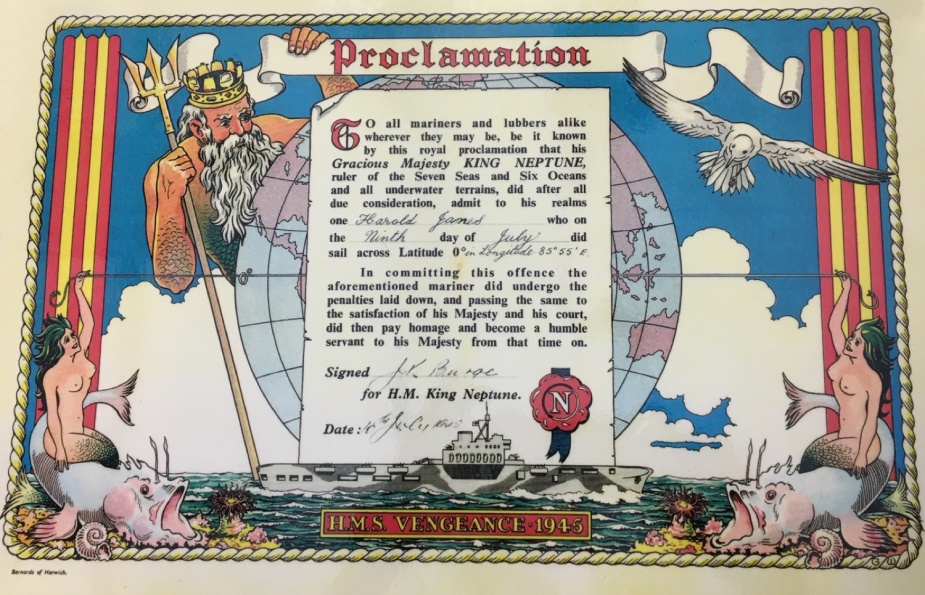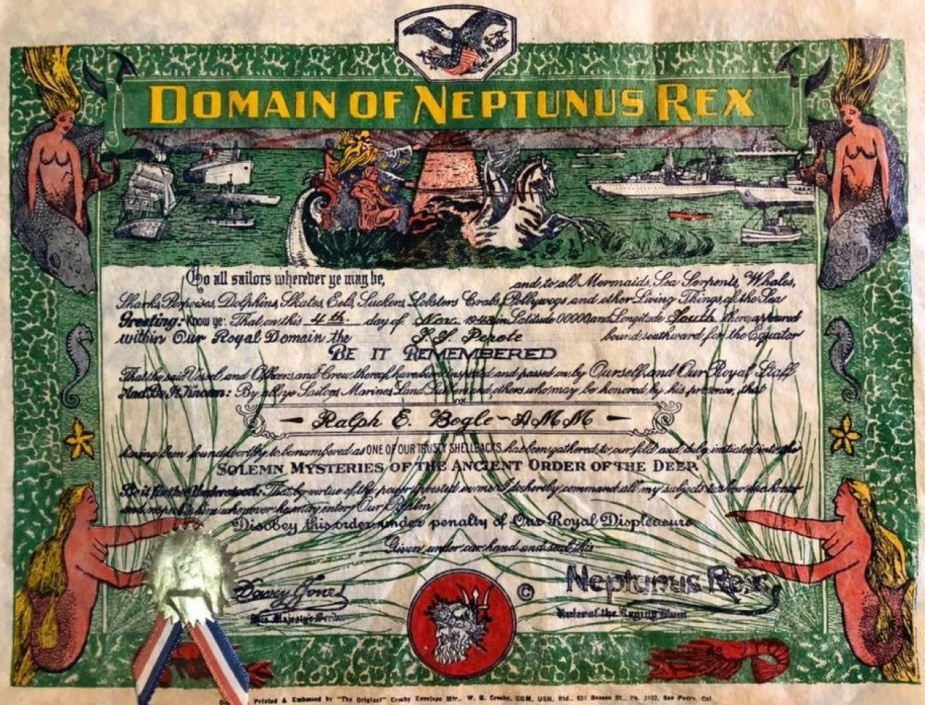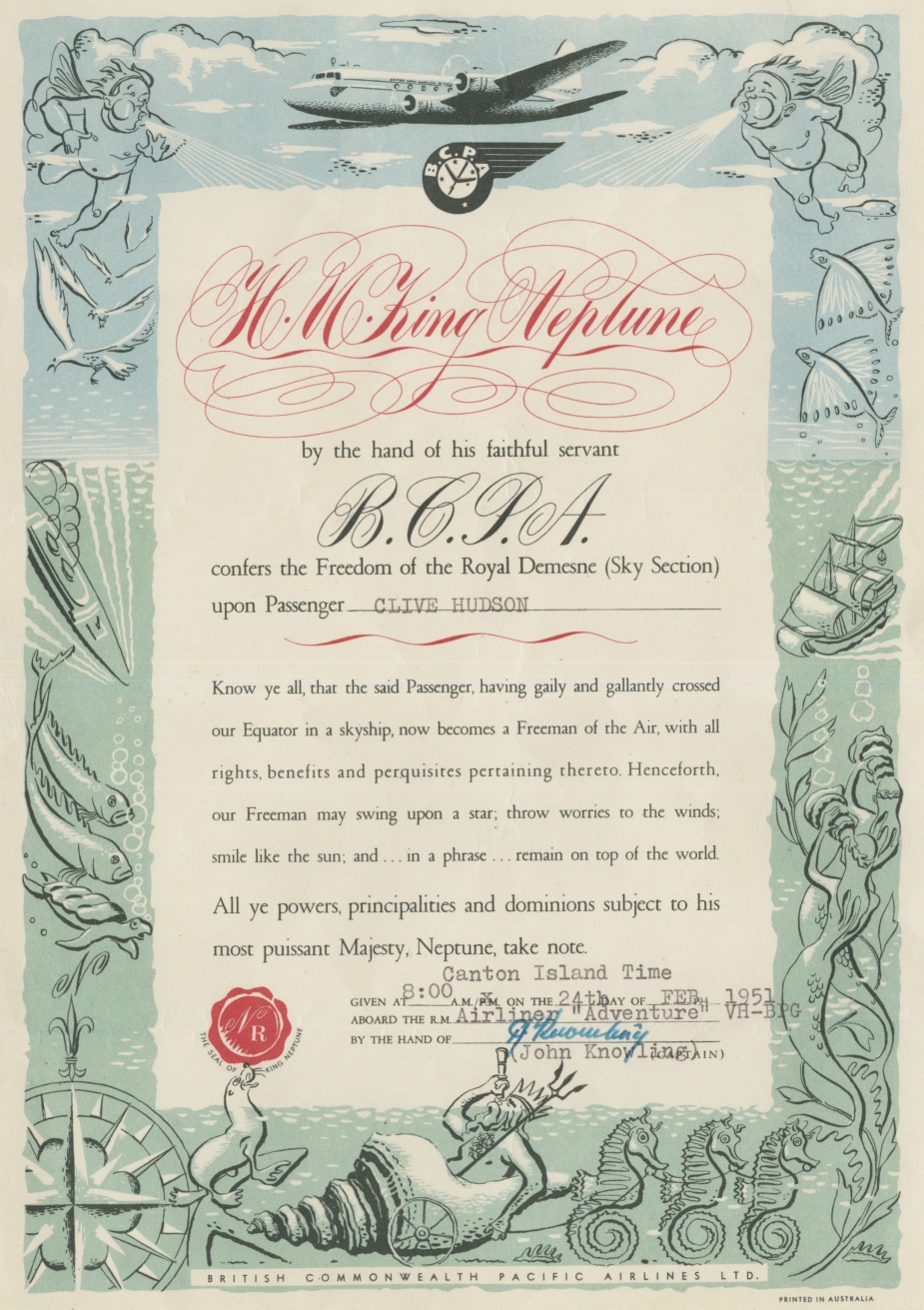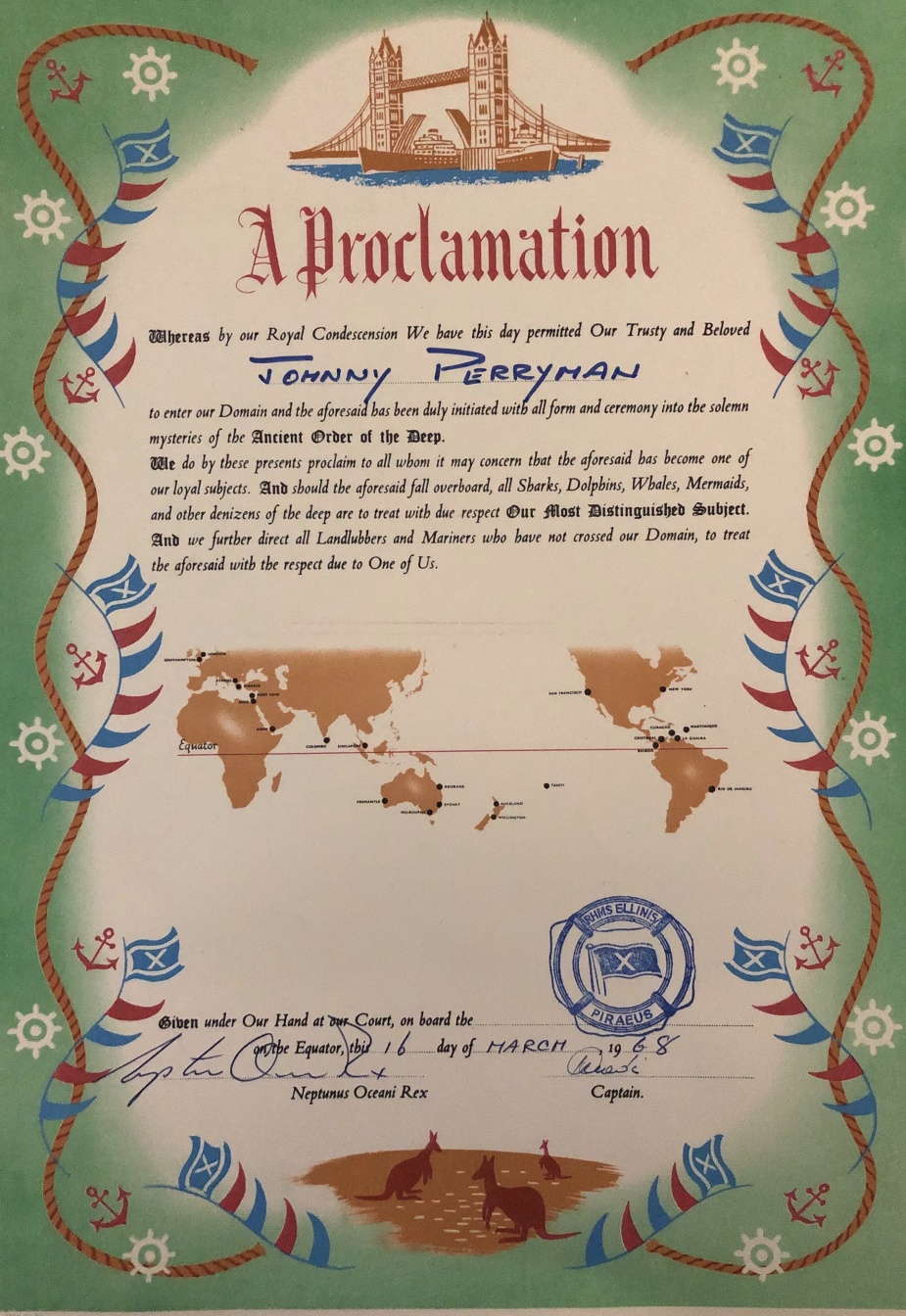Crossing the Line
Introduction
The custom of nautical ‘Crossing the Line’ ceremonies has its origins in ancient times. History reveals that the Phoenicians of the Mediterranean, when passing through the straits of Gibraltar to trade with Britons, would often engage in religious ceremonies of appeasement to the God of the Seas during their voyages. The Vikings of Northern Europe also had their own geographical parallels.
The present-day ceremony is thought to have originated from the superstitions of those days and over time the custom made its way to the English-speaking world. The ceremony eventually lost its religious aspects becoming, to a large extent, a means of inducting young novices into the world-wide fraternity of mariners.
The Conduct of the Ceremony
Today the ceremony is performed chiefly to foster a sense of belonging among junior members of a ship’s company. Crossing the line ceremonies were adopted in the Royal Australian Navy fleet following its inception and first voyage from England to Australia in 1913. The modern ceremony follows an approved prescriptive format that ensures the event remains enjoyable and memorable for all concerned.
The ceremony usually takes place when one of HMA ships first crosses the equator during an overseas deployment. The mythological god of the seas, Neptune or ‘Neptunus Rex’ (Ruler of the Deep) is the ‘Majesty’ to whom homage is paid. He is usually portrayed by a senior member of a ship’s company, often a Chief Petty Officer. King Neptune is accompanied by an entourage of other senior members of the ship’s company who have a talent for theatrics and who dress in vivid and colourful attire for the occasion.
Composition of the Court
The Royal Court normally comprises:
- First assistant Davy Jones - of Davy Jones’ locker fame;
- Her Royal Highness Amphitrite - formerly Poseidon’s wife but adopted by Neptune after he defeated Poseidon;
- A Royal Baby - whose presence demands an equal measure of respect,
- A Royal Messenger - who delivers summons on behalf of King Neptune;
- A Royal Herald - who proclaims the arrival of King Neptune and his entourage;
- A Royal Barber - who prepares candidates for their appearance before the court;
- The Royal Doctor - who assesses the physical aptitude of candidates;
- The Royal Judge - who hears charges brought against the uninitiated and takes mitigation into consideration while deliberating on behalf of Neptune;
- A Royal Scribe - who reads charges and keeps official records of proceedings;
- Neptune’s Police - who are responsible for overseeing proceedings;
- Royal Bodyguard - King Neptune’s personal and most trusted attendants; and
- Bears - helpers responsible for the baptism of all candidates who volunteer to appear before the court. Gaining acceptance into the Ancient Order of The Deep requires candidates to be doused in the salty sacred waters of His Majesty’s dominions.
Pollywogs, Tadpoles & Shellbacks
Members of a ship’s company who have never crossed the equator onboard a warship are known as ‘Pollywogs’ or ‘Tadpoles’. Members who have previously paid homage to Neptune and who have been inducted into his realm are known as trusty ‘Shellbacks’. These staid hands usually dress up to observe and enjoy the ceremony, which provides great levity and a break from a ship’s normal routine. A Golden Shellback is one who has had the honour of crossing the equator where it dissects with the international date line in the Pacific Ocean. Rarer still are Emerald Shellbacks who have the distinction of having crossed the equator at the Prime Meridian in the Gulf of Guinea west Africa. One RAN officer, Lieutenant Chris Hole, had the unusual distinction of becoming a 'Golden Shellback' when he crossed the 180th meridian while serving in HM Royal Yacht Britannia. The certificate awarded to him is a rare nautical treasure.
The Summons
The night before a ship is scheduled to cross the equator, or ‘line’ as it is commonly known, it is customary that Davy Jones, the Royal Herald, Police and Bears will repair onboard and seek an audience with the Commanding Officer announcing their intention to convene Neptune’s court. This interaction will often be broadcast throughout the ship declaring when and where proceedings are to take place. At the same time all ‘pollywogs’ wishing to become ‘shellbacks’ receive a summons to appear before Neptune. The following day the Bears will move through the ship rounding up those wishing to appear before King Neptune’s colourful court.
Generally, the Pollywogs will be paraded before the Royal party having been made ready by the Royal Barber and Doctor. The offence of ‘presuming to cross the line without seeking prior consent from King Neptune’ is normally the charge levelled at most. Defence testimonies may be received, but it is rare for a Pollywog to escape being dipped in brine, a token baptism carried out by the Bears. The timbre of the ceremony should be good humoured and enjoyable for all those participating. For most it is a much-anticipated milestone in sea-going careers that is remembered fondly.
The Ancient Order of the Deep
Having become trusty Shellbacks inductees are again brought before the Royal Party and their worthiness to be admitted to the Ancient Order of the Deep assessed. After being welcomed in the Neptune’s Realm the Royal Party departs and an appropriate celebration is held to commemorate the event. Often in the form of a ‘steel beach’ barbeque.
Certificates
In recognition of this important milestone all newly appointed Shellbacks are presented with an ornate certificate confirming their new title and status. Many different variants may be found in the world’s navies and merchant fleets and these often become treasured souvenirs. A well-conducted ceremony will leave a fond and lasting impression on all as they are welcomed into the fraternity of the world’s mariners.


